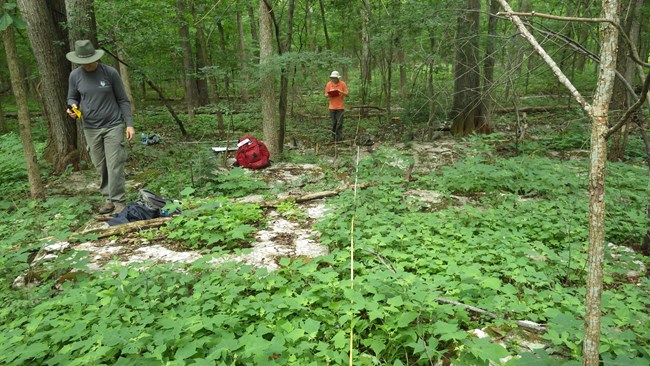
NPS Photo
One of the bloodiest battles of the Civil War occurred at Stones River during late 1862–early 1863 where 81,000 men fought for control of middle Tennessee. Although the battle was considered to be tactically indecisive, General Rosecrans claimed victory for the Union forces after General Bragg and his Confederate troops withdrew. Stones River National Battlefield is a 700 acre site consisting of multiple units, one of which includes a National Cemetery with over 6,000 Union graves. The area is characterized by rolling terrain with upland hardwood forests and successional communities dominated by eastern red cedar. Unique habitats include rock outcrops, numerous limestone cedar glades containing endemic plant species, and a small tract of oak-hickory woods. West Fork Stones River, and its tributary Lytle Creek, have associated limestone bluffs, floodplains, and springs.
The Cumberland Piedmont Network inventory program has provided this park with a vegetation community classification and map, a wetlands inventory, and updated vascular plant and vertebrate species lists. During the vegetation community classification work, 20 distinct associations were documented and mapped, including the globally rare limestone glades.
The Network monitoring program at this park includes four vital signs that involve repeated visits to established sites, following procedures established by each monitoring protocol. These four vital signs are: forest vegetation communities, invasive species early detection, ozone/foliar injury, and water quality. Water quality monitoring began in 2003 and continues on a monthly schedule for two years "on," five years "off," at four sites. Forest monitoring began in 2011–2012 with the establishment of 16 long-term monitoring plots. Â More new plots will be established over the next couple years, followed by a five-year revisit schedule, occurring in July. Ozone levels and foliar injury are assessed on-site every six years, beginning in 2010. The Invasive Species Early Detection protocol was completed in 2012 and will be used by field crews to monitor for priority exotics during their scheduled field work.
Park managers are using inventory and monitoring data to create resource stewardship strategies for achieving desired future conditions. The links to inventory and monitoring reports are provided on this page.
For more Information contact:
Steve Thomas, Network Program Manager, CUPN offices at Mammoth Cave NP
Select a Park:
Select a Species Category (optional):
Visit NPSpecies for more comprehensive information and advanced search capability. Have a suggestion or comment on this list? Let us know.
Last updated: January 12, 2021
